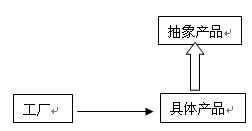設計模式學習(一) 工廠模式之簡單工廠
Creational Pattern:
*creates objects for you rather than having you instantiate objects directly
*gives your program more flexibility in deciding which objects need to be created for a given case
工廠模式有以下三種形態(tài):
● 簡單工廠(Simple Factory)模式:又稱靜態(tài)工廠方法(Static Factory Method)模式
● 工廠方法(Factory Method)模式:又稱多態(tài)性工廠(Polymorphic Factory)模式
● 抽象工廠(Abstract Factory)模式:又稱工具箱(Kit 或 Toolkit)模式
簡單工廠模式其實是普通工廠模式的一個特例,今天就從這里開始吧。
其結(jié)構(gòu)可以簡單地表示如下:
 沒用Visio畫,大家見諒呀
沒用Visio畫,大家見諒呀
我們從一個實際的例子來看這個簡單工廠模式
假設一個農(nóng)場,專門向市場銷售各種水果,假設只提供良種的水果,蘋果和葡萄,我們?yōu)樗O計一個抽象類Fruit,所有水果都必須實現(xiàn)這個接口
 package simple_Factory;
package simple_Factory; //水果抽象出來的接口
//水果抽象出來的接口
 public interface Fruit
public interface Fruit  {
{ void grow();
void grow(); void harvest();
void harvest(); }
}

 public class Apple implements Fruit
public class Apple implements Fruit  {
{
 private int treeAge;
private int treeAge;

 public void grow()
public void grow()  {
{ log("Apple is glowing");
log("Apple is glowing");
 }
}

 private void log(String string)
private void log(String string)  {
{ System.out.println(string);
System.out.println(string);  }
}

 public void harvest()
public void harvest()  {
{ log("Apple has been harvested.");
log("Apple has been harvested."); }
}

 public int getTreeAge()
public int getTreeAge()  {
{ return treeAge;
return treeAge; }
}

 public void setTreeAge(int treeAge)
public void setTreeAge(int treeAge)  {
{ this.treeAge = treeAge;
this.treeAge = treeAge; }
}
 }
}

 public class Grape implements Fruit
public class Grape implements Fruit  {
{
 private boolean seedless;
private boolean seedless;
 public void grow()
public void grow()  {
{ log("Grape is growing------");
log("Grape is growing------"); }
}


 public void harvest()
public void harvest()  {
{ log("Grape has been harvested.");
log("Grape has been harvested."); }
}
 private void log(String string)
private void log(String string)  {
{ System.out.println(string);
System.out.println(string);  }
}

 public boolean isSeedless()
public boolean isSeedless()  {
{ return seedless;
return seedless; }
}

 public void setSeedless(boolean seedless)
public void setSeedless(boolean seedless)  {
{ this.seedless = seedless;
this.seedless = seedless; }
}
 }
}

 public class OtherFruits implements Fruit
public class OtherFruits implements Fruit  {
{

 public void grow()
public void grow()  {
{
 }
}

 public void harvest()
public void harvest()  {
{
 }
}
 }
}
FruitFactory類,水果加工廠,根據(jù)需要(不同參數(shù)代表不同的水果需求)給市場供給水果。
 package simple_Factory;
package simple_Factory;
 //水果加工廠,根據(jù)需要給市場供給水果
//水果加工廠,根據(jù)需要給市場供給水果
 public class FruitFactory
public class FruitFactory  {
{ public static Fruit supplyFruit(String need)
public static Fruit supplyFruit(String need)

 {
{ if(need.equalsIgnoreCase("apple"))
if(need.equalsIgnoreCase("apple")) return new Apple();
return new Apple(); else if(need.equalsIgnoreCase("grape"))
else if(need.equalsIgnoreCase("grape")) return new Grape();
return new Grape(); else
else return new OtherFruits();
return new OtherFruits();  }
} }
}測試方法:
 package simple_Factory;
package simple_Factory;

 public class Test
public class Test  {
{

 /** *//**
/** *//** * @param args
* @param args */
*/
 public static void main(String[] args)
public static void main(String[] args)  {
{ Fruit a = FruitFactory.supplyFruit("apple");
Fruit a = FruitFactory.supplyFruit("apple"); Fruit b = FruitFactory.supplyFruit("Grape");
Fruit b = FruitFactory.supplyFruit("Grape"); Fruit c = FruitFactory.supplyFruit("others");
Fruit c = FruitFactory.supplyFruit("others");
 a.grow();a.harvest();
a.grow();a.harvest(); b.grow();b.harvest();
b.grow();b.harvest(); c.grow();c.harvest();
c.grow();c.harvest(); }
} }
}
自己弄懂和講給別人懂還是有很大差距的,第一篇文章雖然寫好了,但是感覺不夠好,不知道能不能給初學者一點點幫助呢……
自強不息,繼續(xù)努力!



